Research on 3D-Print Design Method of Spatial Node Topology Optimization Based on Improved Material Interpolation
Abstract
:1. Introduction
2. BESO Topology Optimization Method
2.1. Mathematical Description of Topology Optimization
2.2. Improved Material Interpolation Method
2.3. Optimization Criteria
2.4. Optimization of the Process
- (1)
- Firstly, establish the ABAQUS finite element model that needs to be optimized, and output the finite element calculation model INP file.
- (2)
- ABAQUS is called through the MATLAB background to perform the finite element analysis. After the calculation and analysis are completed, the ODB database function of Python is used to extract all the element design variables Xi of the solved design domain.
- (3)
- Then, the sensitivity analysis based on the improved material interpolation method is performed on the extracted data in MATLAB, and then the optimization analysis is performed based on the optimization criterion.
- (4)
- The elements that need to be deleted and retained are divided into different element sets, written as a new finite element model INP file, and iterated again until the target volume fraction is reached and the optimization ends.
- (5)
- After the optimization, extract the 3D model format file of the finite element model composed of the retained element set, and perform the additive manufacturing.
3. Space Node Optimization-Manufacturing Example
3.1. Model Parameters and Modeling
3.2. Optimization Effect before and after Improvement
3.3. Analysis of Optimization Results under Different Working Conditions
3.3.1. Axial Force Acting Conditions
3.3.2. Shear Conditions
3.3.3. Combined Load Conditions
3.4. Algorithm Comparison
4. Optimizing Results for Additive Manufacturing
4.1. Model Postprocessing
4.2. 3D-Printing Effect
5. Conclusions
- (1)
- The material interpolation method of the optimization algorithm was improved, the penalty effect of the material method was strengthened, and the adaptability was increased. Compared with the SIMP method, the secondary developed BESO method did not easily fall into the optimal local solution, and the performance of the obtained optimization results was better.
- (2)
- Based on the multisoftware collaborative computing platform independently developed by the research group and the model extraction method proposed in this paper, there was no need to modify the model grid and edit it again, so the method could easily and quickly realize the entire process of design-manufacturing.
Author Contributions
Funding
Institutional Review Board Statement
Informed Consent Statement
Data Availability Statement
Conflicts of Interest
References
- Xie, Y.M.; Steven, G. A simple evolutionary procedure for structural optimization. Comput. Struct. 1993, 49, 885–896. [Google Scholar] [CrossRef]
- Yang, X.Y.; Xie, Y.M.; Steven, G.P.; Querin, O.M. Bidirectional evolutionary method for stiffness optimization. AIAA J. 1999, 37, 1483–1488. [Google Scholar] [CrossRef]
- Langelaar, M. Topology optimization of 3D self-supporting structures for additive manufacturing. Addit. Manuf. 2016, 12, 60–70. [Google Scholar] [CrossRef] [Green Version]
- Zhang, W.; Li, D.; Zhang, J.; Guo, X. Minimum length scale control in structural topology optimization based on the Moving Morphable Components (MMC) approach. Comput. Methods Appl. Mech. Eng. 2016, 311, 327–355. [Google Scholar] [CrossRef]
- Zhou, M.; Lazarov, B.S.; Wang, F.; Sigmund, O. Minimum length scale in topology optimization by geometric constraints. Comput. Methods Appl. Mech. Eng. 2015, 293, 266–282. [Google Scholar] [CrossRef] [Green Version]
- Dapogny, C.; Estevez, R.; Faure, A.; Michailidis, G. Shape and topology optimization considering anisotropic features induced by additive manufacturing processes. Comput. Methods Appl. Mech. Eng. 2018, 344, 626–665. [Google Scholar] [CrossRef] [Green Version]
- Li, S.; Yuan, S.; Zhu, J.; Wang, C.; Li, J.; Zhang, W. Additive Manufacturing-driven Design Optimization: Building Direction and Structural Topology. Addit. Manuf. 2020, 36, 101406. [Google Scholar] [CrossRef]
- Lian, Y.P.; Wang, P.D.; Gao, J.; Liu, J.K.; Li, Q.H.; Liu, C.M.; He, X.F.; Gao, L.; Li, H.; Lei, H.S.; et al. Research progress on some key mechanical problems in metal additive manufacturing. Adv. Mech. 2021, 51, 648–701. [Google Scholar]
- Alsalla, H.H.; Smith, C.; Liang, H. Effect of build orientation on the surface quality, microstructure and mechanical properties of selective laser melting 316L stainless steel. Rapid Prototyp. J. 2018, 24, 9–17. [Google Scholar] [CrossRef]
- Rezayat, H.; Zhou, W.; Siriruk, A.; Penumadu, D.; Babu, S.S. Structure-mechanical property Relationship in fused deposition modelling. Mater. Sci. Technol. 2015, 31, 895–903. [Google Scholar] [CrossRef]
- Carneiro, O.S.; Silva, A.F.; Gomes, R. Fused deposition modeling with polypropylene. Mater. Des. 2015, 83, 768–776. [Google Scholar] [CrossRef]
- Sohrabian, M.; Vaseghi, M.; Khaleghi, H.; Dehrooyeh, S.; Kohan, M.S.A. Structural Investigation of Delicate-Geometry Fused Deposition Modeling Additive Manufacturing Scaffolds: Experiment and Analytics. J. Mater. Eng. Perform. 2021, 30, 6529–6541. [Google Scholar] [CrossRef]
- Li, X.F. Classification and Analysis of Foreign Additive Manufacturing Standards. Electr. Mach. Tool. 2020, 5, 56–59. [Google Scholar]
- Han, L.Y.; Du, W.F.; Xia, Z.; Ye, J.; Gao, B.Q. Research on generative intelligent design of four-forked cast steel joints. J. Build. Struct. 2022, 29, 1–13. [Google Scholar]
- Ji, P.; Chen, Y.L.; Jang, T.; Banon, C. Topology Optimization of Airmesh Metal Additive Manufacturing Nodes. Space Struct. 2021, 27, 71–77. [Google Scholar]
- Zhou, Y.C.; Zhao, Y.; Xiang, X.A. Research on topology optimization of cable dome nodes in Ya’an Tianquan Gymnasium. Space Struct. 2021, 27, 74–80. [Google Scholar]
- Strauss, H. AM Envelope: The Potential of Additive Manufacturing for Facade Constructions; TU Delft: Delft, The Netherlands, 2013. [Google Scholar]
- Sigmund, O. A 99 line topology optimization code written in Matlab. Struct. Multidiscip. Optim. 2001, 21, 120–127. [Google Scholar] [CrossRef]
- Liu, K.; Tovar, A. An efficient 3D topology optimization code written in Matlab. Struct. Multidiscip. Optim. 2014, 50, 1175–1196. [Google Scholar] [CrossRef] [Green Version]
- Huang, X.; Xie, Y.M. Bi-directional evolutionary topology optimization of continuum structures with one or multiple materials. Comput. Mech. 2009, 43, 393–401. [Google Scholar] [CrossRef]
- Bendsøe, M.P.; Sigmund, O. Material interpolation schemes in topology optimization. Ingenieur-Archiv 1999, 69, 635–654. [Google Scholar] [CrossRef]
- Wang, X.J.; Zhang, X.A. Multiphase material layout and material/structure integrated design. Chin. J. Solid Mech. 2014, 35, 341–346. [Google Scholar]
- Chen, M.C.; Zhao, Y.; Xie, Y.M. Topology optimization and additive manufacturing of spatial structure nodes. China Civ. Eng. J. 2019, 52, 1–10. [Google Scholar]
- Zhao, Y.; Chen, M.C.; Wang, Z. Topology optimization design of cable and rod structure nodes for additive manufacturing. J. Build. Struct. 2019, 40, 58–68. [Google Scholar]
- Wang, L.X.; Du, W.F.; Zhang, F.; Zhang, H.; Gao, B.Q.; Dong, S.L. Topology optimization and 3D printing manufacturing of four-branch cast steel joints. J. Build. Struct. 2021, 42, 37–49. [Google Scholar]

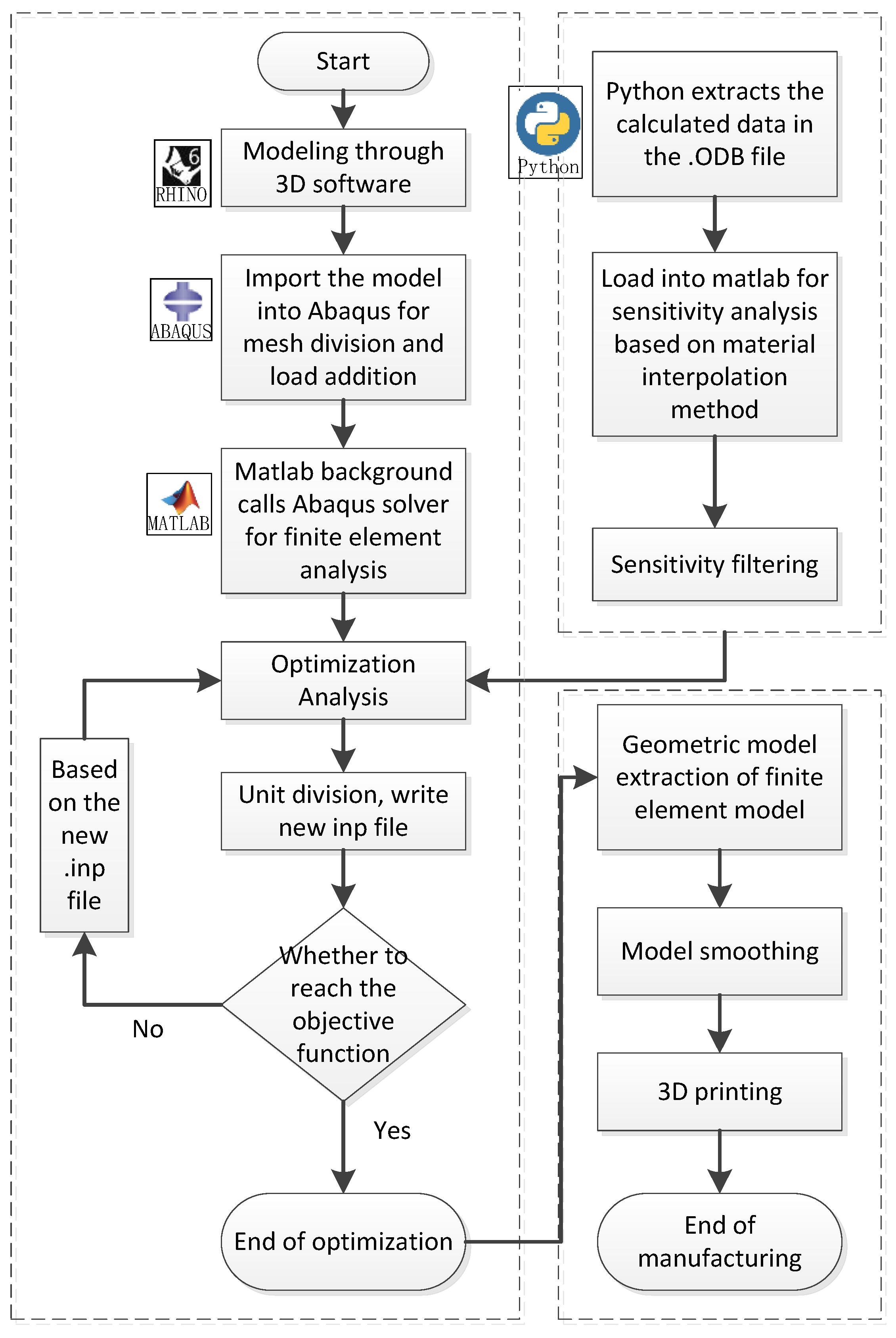

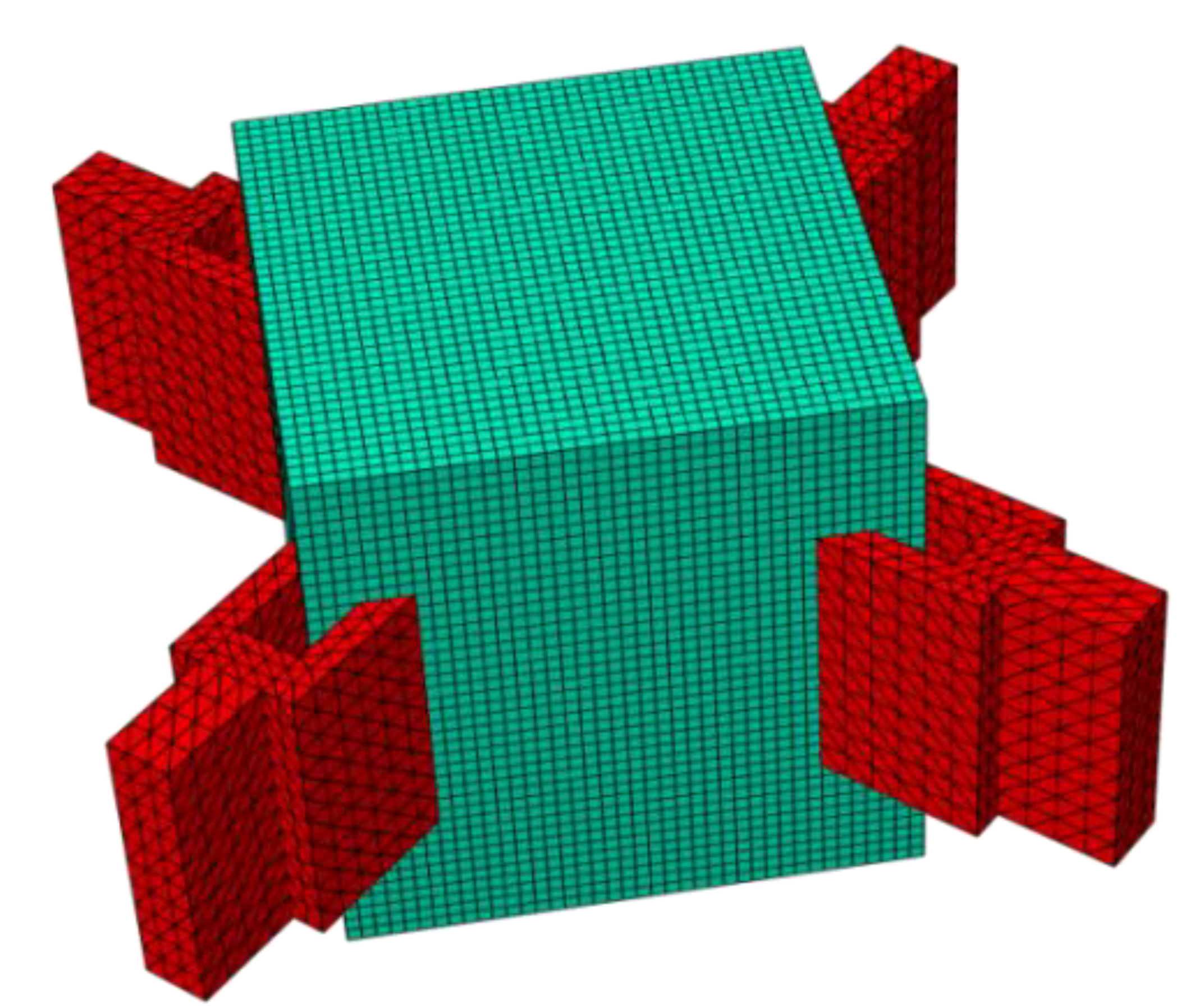



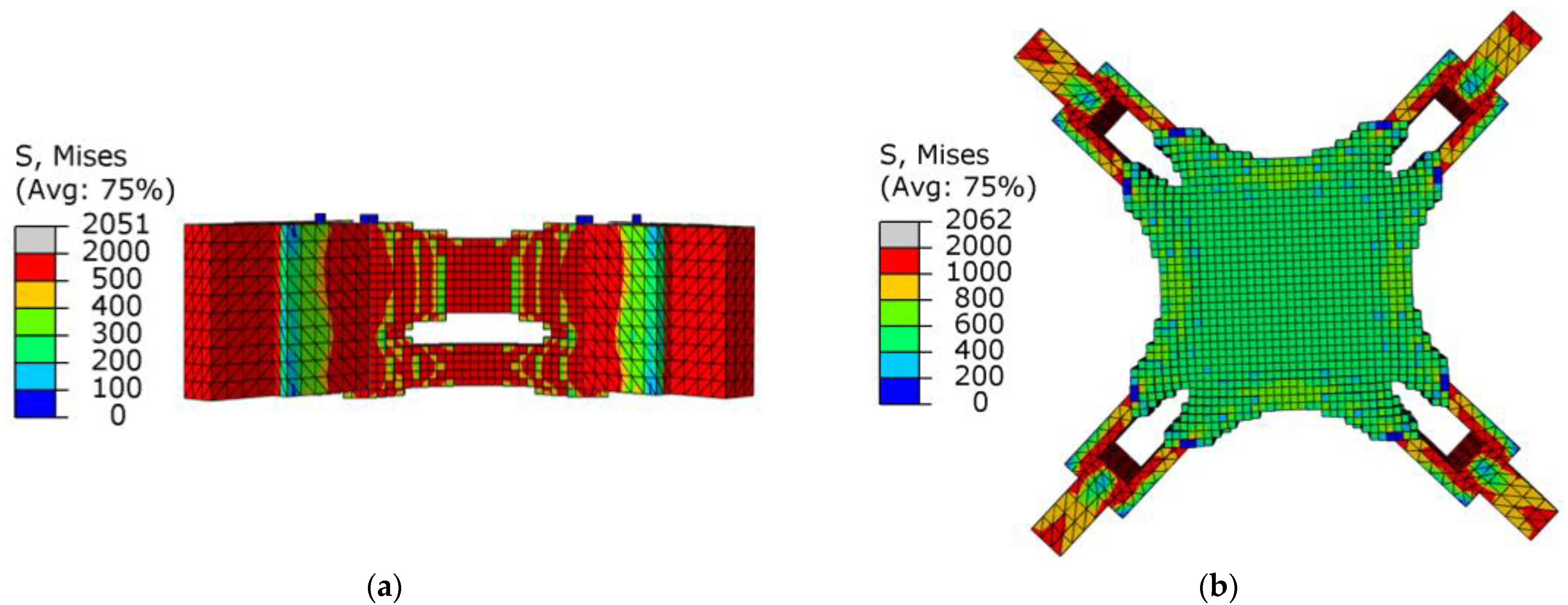



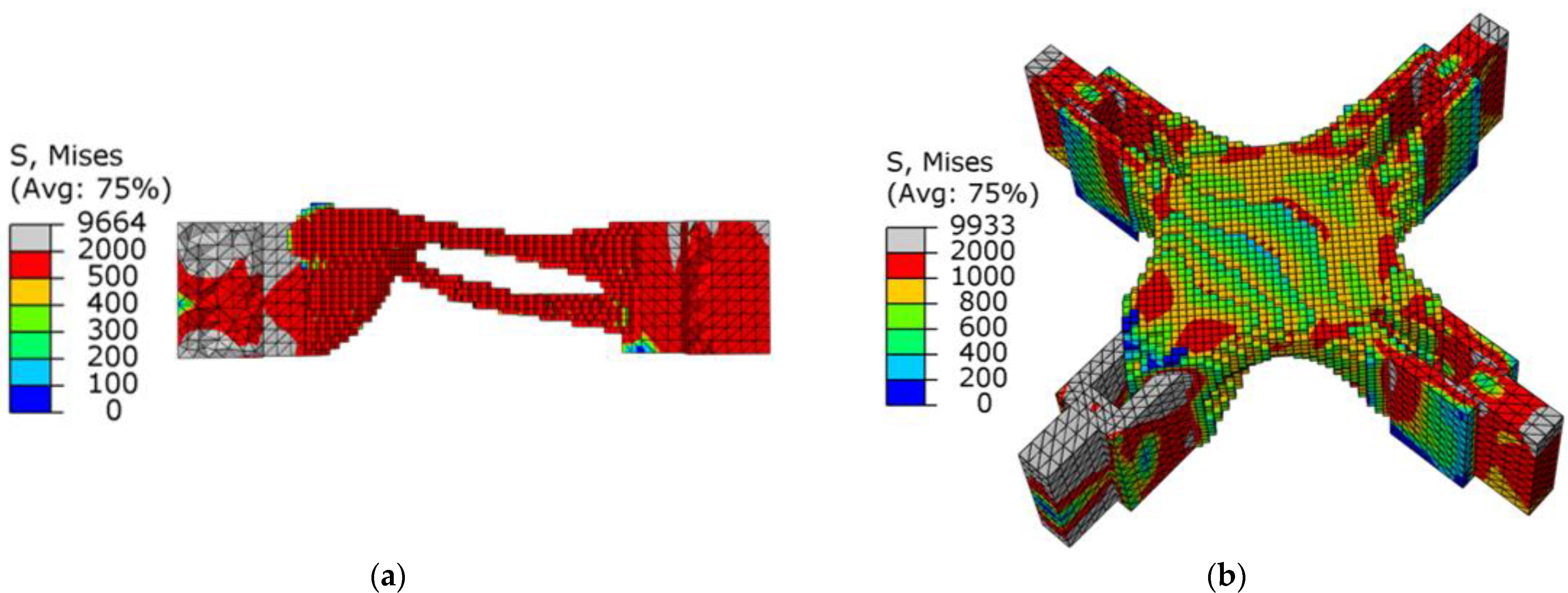
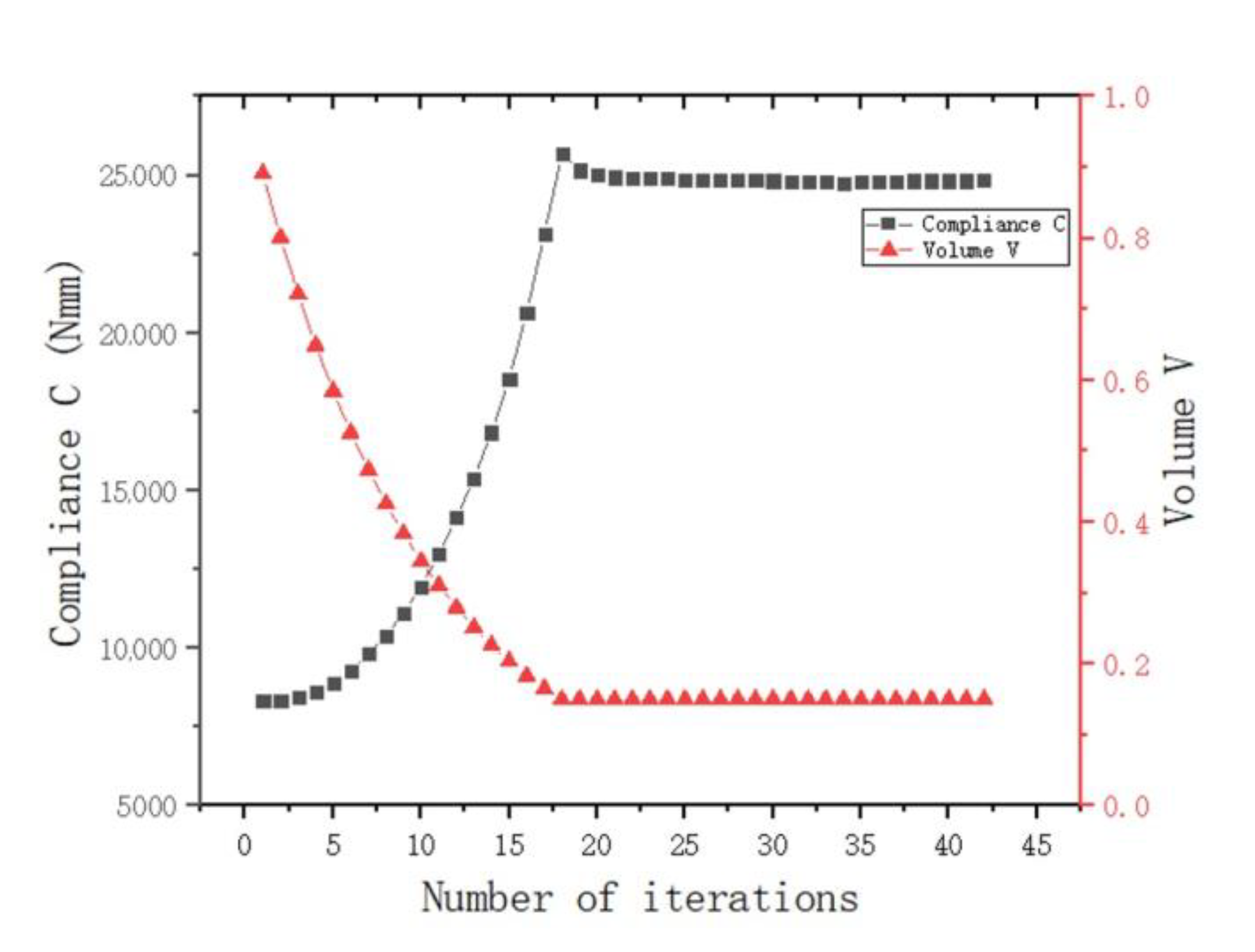
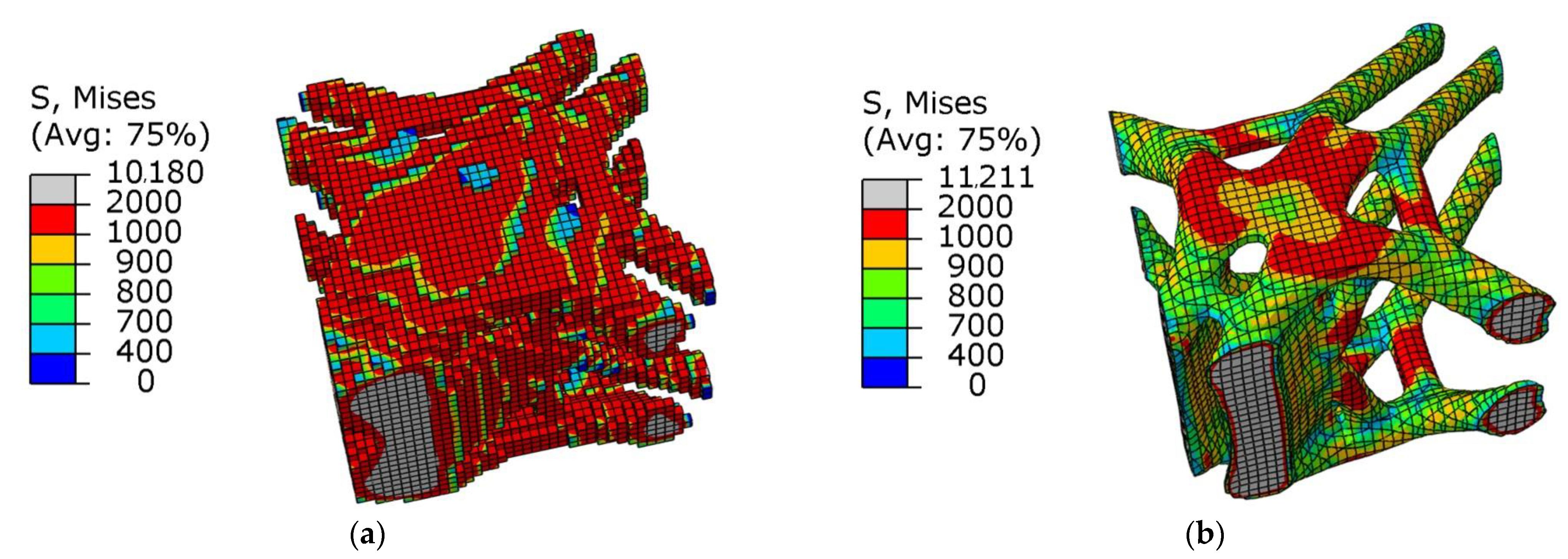
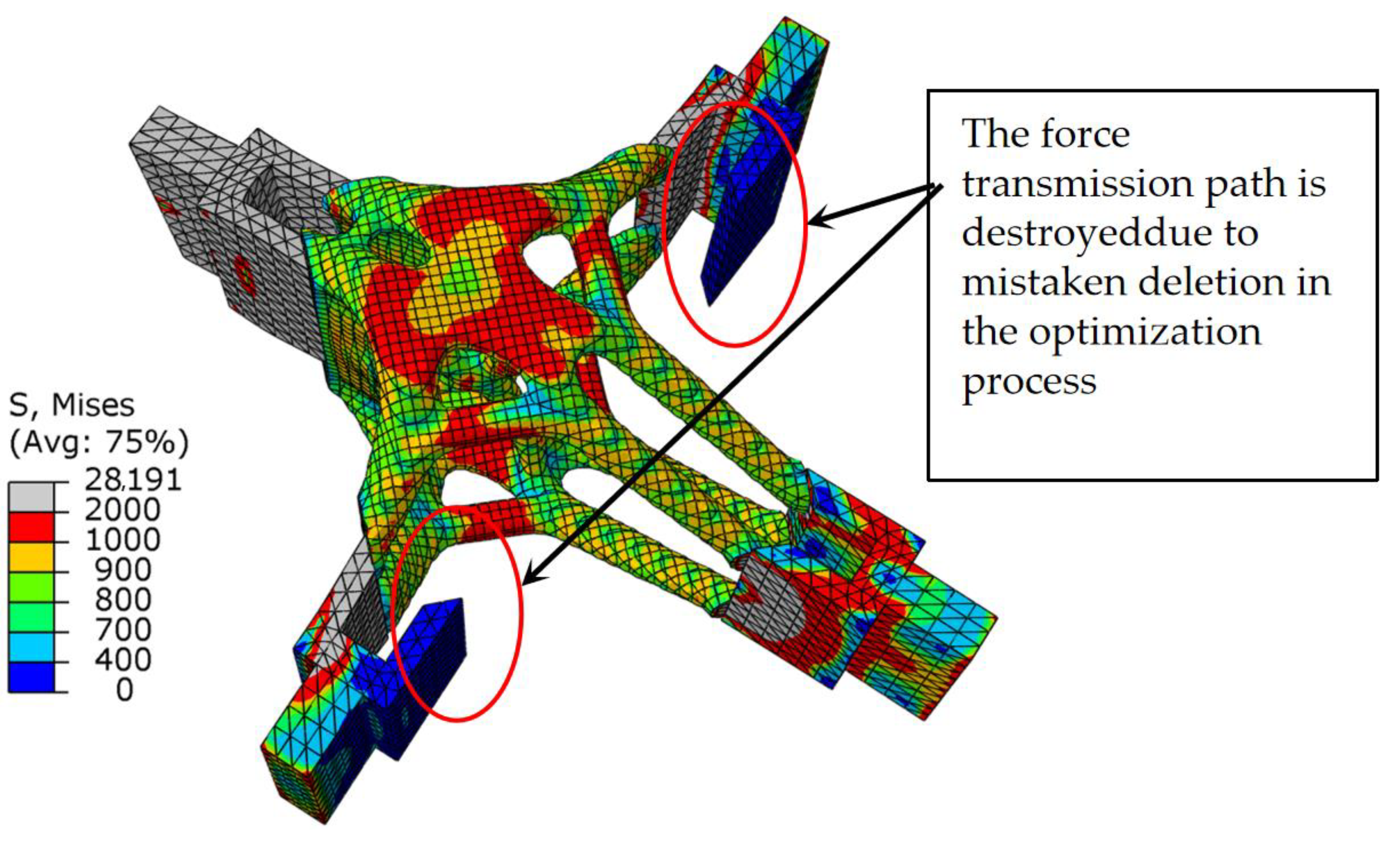
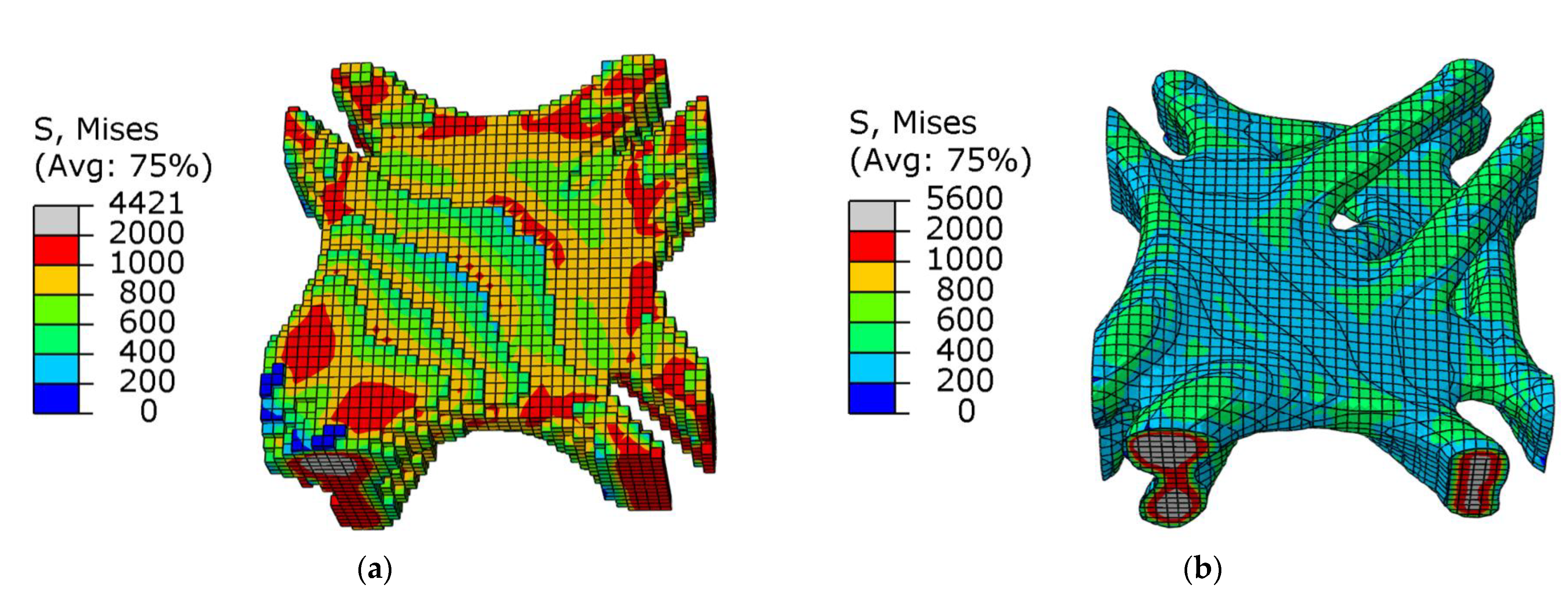
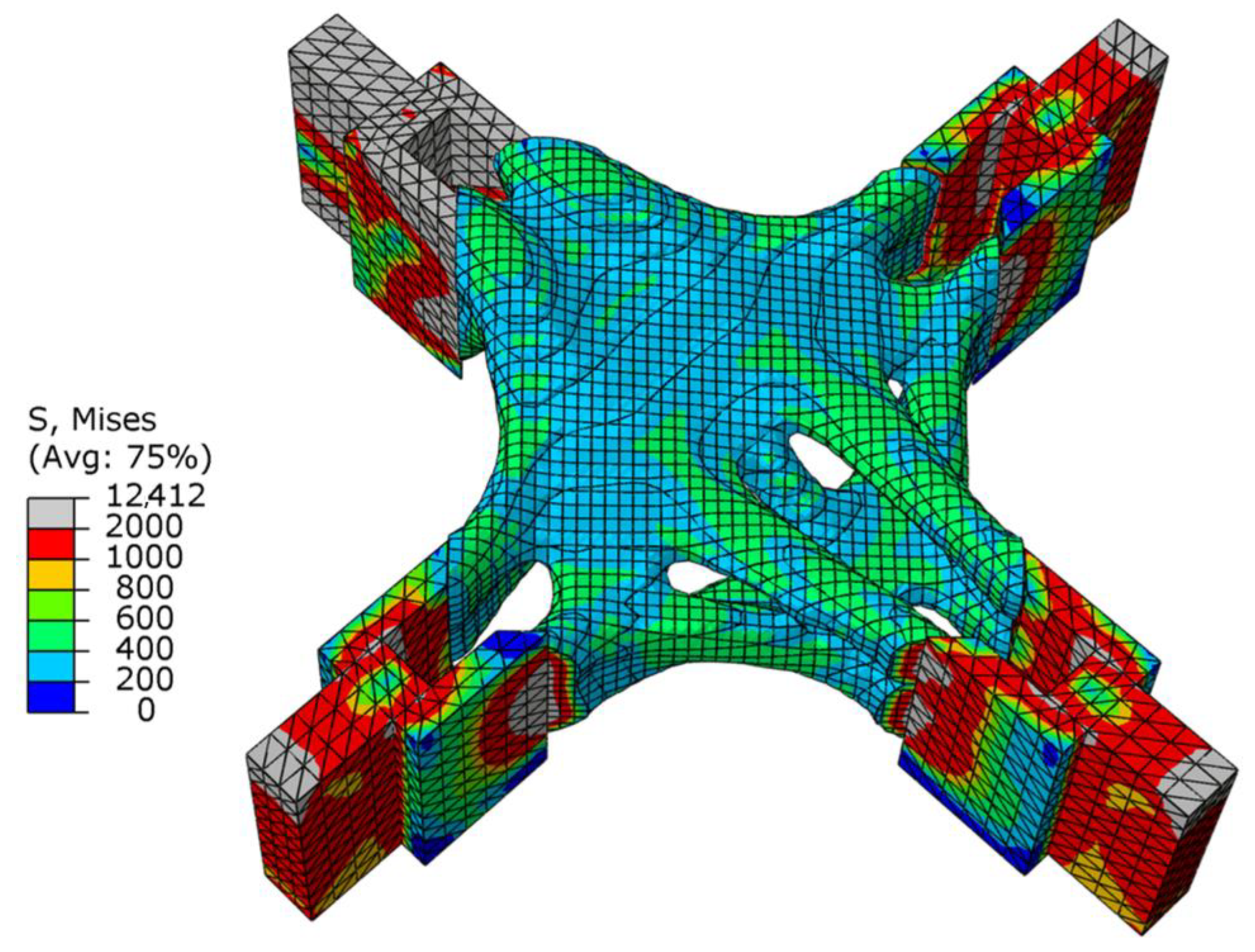

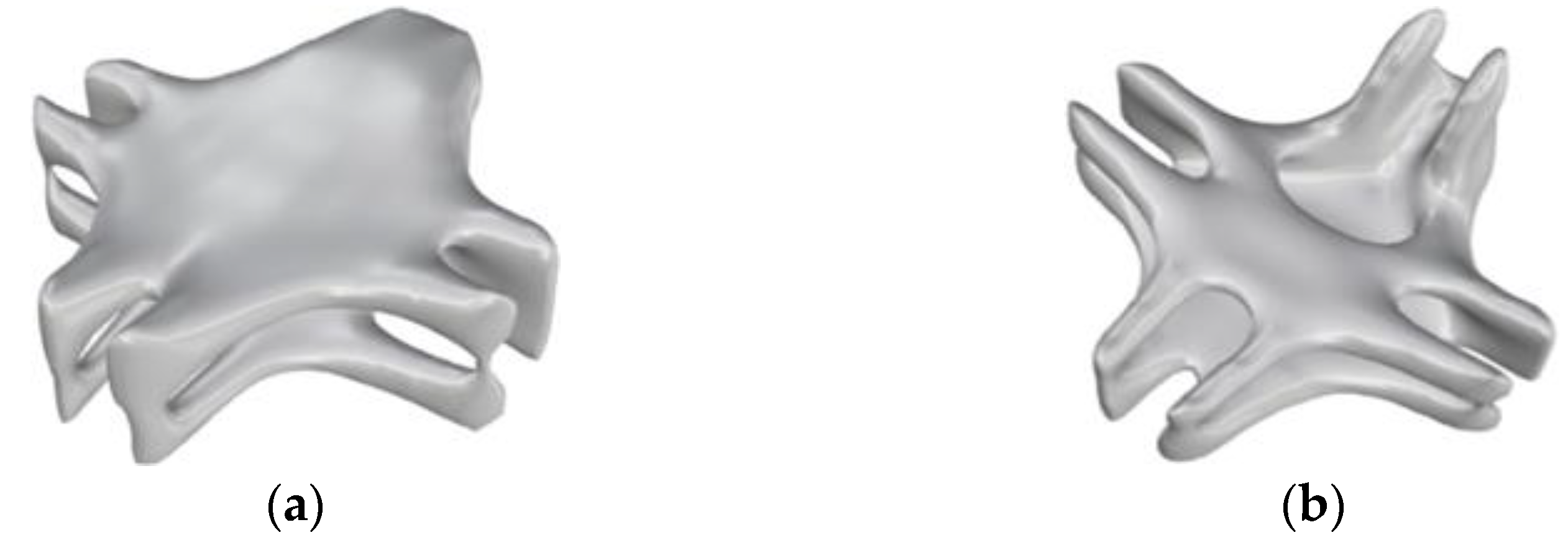
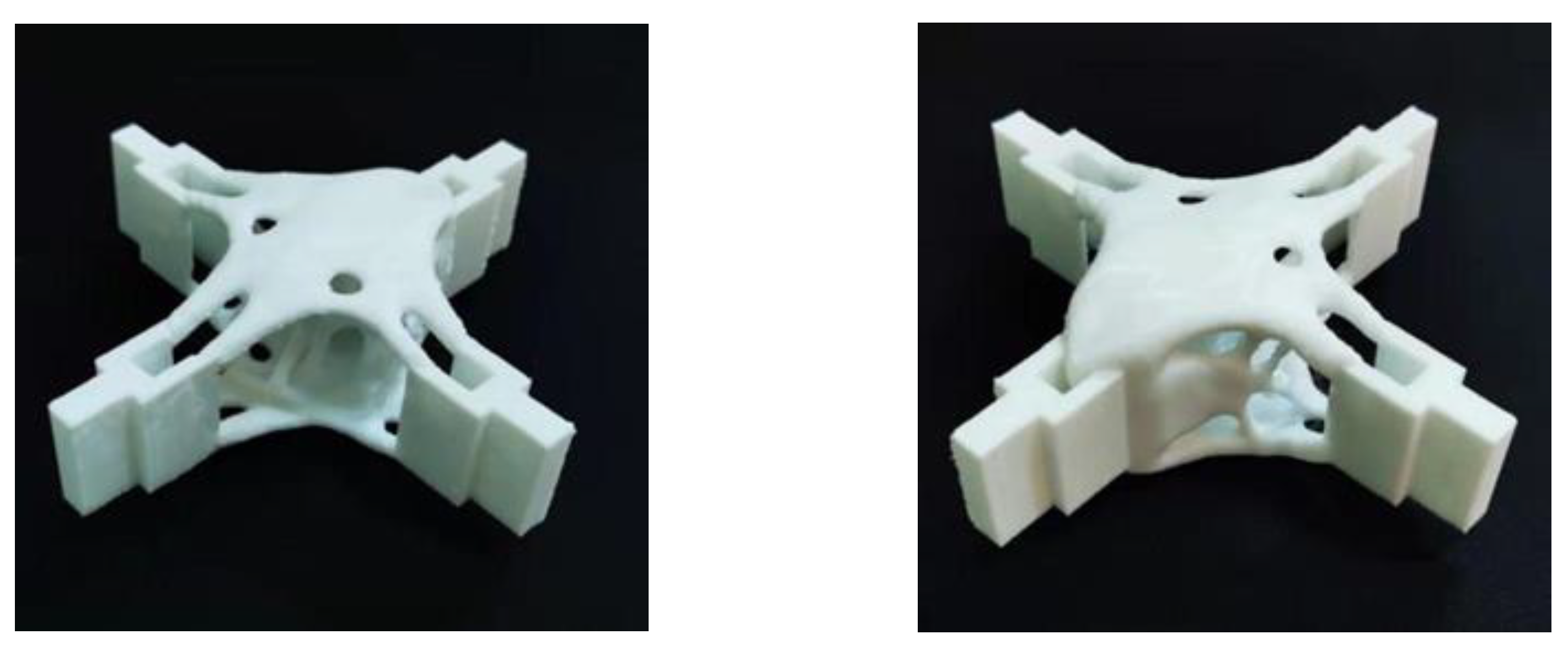

| Structure Size (mm) | Density (kg/m3) | Elastic Modulus (MPa) | Poisson’s Ratio | |
|---|---|---|---|---|
| Design domain | 80 × 80 × 80 | 7850 | 2.1 × 105 | 0.28 |
| Ear plate thickness | 10 | 7850 | 2.1 × 105 | 0.28 |
| Ear plate height | 40 | 7850 | 2.1 × 105 | 0.28 |
| Algorithm | Maximum Stress (MPa) | Minimum Stress (MPa) |
|---|---|---|
| BESO | 10,180 | 11.34 |
| SIMP | 11,210 | 4.1 × 10−6 |
| Algorithm | Maximum Stress (MPa) | Minimum Stress (MPa) |
|---|---|---|
| BESO | 4421 | 58 |
| SIMP | 5600 | 2.2 × 10−6 |
| Print Type | Material | Speed (mm/s) | Fill Rate | Temperature (°C) |
|---|---|---|---|---|
| FDM | PLA | 60 | 15% | 220 |
Publisher’s Note: MDPI stays neutral with regard to jurisdictional claims in published maps and institutional affiliations. |
© 2022 by the authors. Licensee MDPI, Basel, Switzerland. This article is an open access article distributed under the terms and conditions of the Creative Commons Attribution (CC BY) license (https://creativecommons.org/licenses/by/4.0/).
Share and Cite
Wang, X.; Zhang, F.; Zhao, Y.; Wang, Z.; Zhou, G. Research on 3D-Print Design Method of Spatial Node Topology Optimization Based on Improved Material Interpolation. Materials 2022, 15, 3874. https://doi.org/10.3390/ma15113874
Wang X, Zhang F, Zhao Y, Wang Z, Zhou G. Research on 3D-Print Design Method of Spatial Node Topology Optimization Based on Improved Material Interpolation. Materials. 2022; 15(11):3874. https://doi.org/10.3390/ma15113874
Chicago/Turabian StyleWang, Xianjie, Fan Zhang, Yang Zhao, Zhaoyi Wang, and Guangen Zhou. 2022. "Research on 3D-Print Design Method of Spatial Node Topology Optimization Based on Improved Material Interpolation" Materials 15, no. 11: 3874. https://doi.org/10.3390/ma15113874
APA StyleWang, X., Zhang, F., Zhao, Y., Wang, Z., & Zhou, G. (2022). Research on 3D-Print Design Method of Spatial Node Topology Optimization Based on Improved Material Interpolation. Materials, 15(11), 3874. https://doi.org/10.3390/ma15113874






